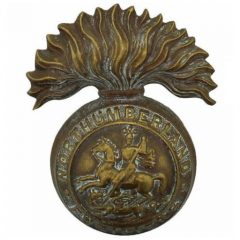Battle of Bellewaarde Wood – 24 & 25 May 1915 Context The last action of the 2nd Battle of Ypres was a successful attempt by the Germans to gain control of the Bellewarde…
You must be logged in to view the content of this Chapter.
Brigade – A Bde consisted of four infantry battalions until spring of 1918, then reduced to three
Battle of Bellewaarde Wood – 24 & 25 May 1915 Context The last action of the 2nd Battle of Ypres was a successful attempt by the Germans to gain control of the Bellewarde…
You must be logged in to view the content of this Chapter.
Sanctuary Wood – June 1915 On Wednesday the 2nd the Royal Field Artillery (RFA) 1 forward observation post sited in the cottage in front of the Bn positions was shelled and set ablaze.…
You must be logged in to view the content of this Chapter.
Historical Context The first and second battles of Ypres were offensives launched by the German Army, but third Ypres was a British initiative aimed at achieving a breakthrough in Flanders and the destruction…
You must be logged in to view the content of this Chapter.
Redeployment During his time in command of the BEF Gen Sir Douglas Haig issued eight despatches, which covered British operations from December 1915 until the end of the war in November 1918. They were…
You must be logged in to view the content of this Chapter.
The 4th Bn settled into the typical routine of life on the Western Front. Taking its turn with the other Bns of the 50th Division in the trenches to the east of Armentieres.
1st August 1915
The author has coloured this map for clarity
Trenches - black, roads and tracks - red. Watercourses - blue
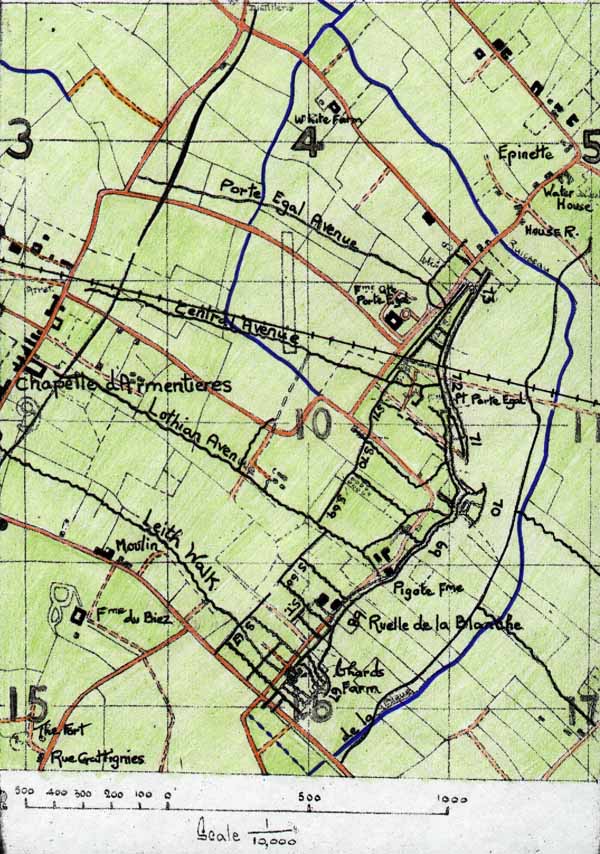
Armentieres Casualties
For information on 4th Bn burial and memorial sites for casualties sustained in this sector, select the link.
If would like to read the full story of the 4th NF in World War 1, then please select here
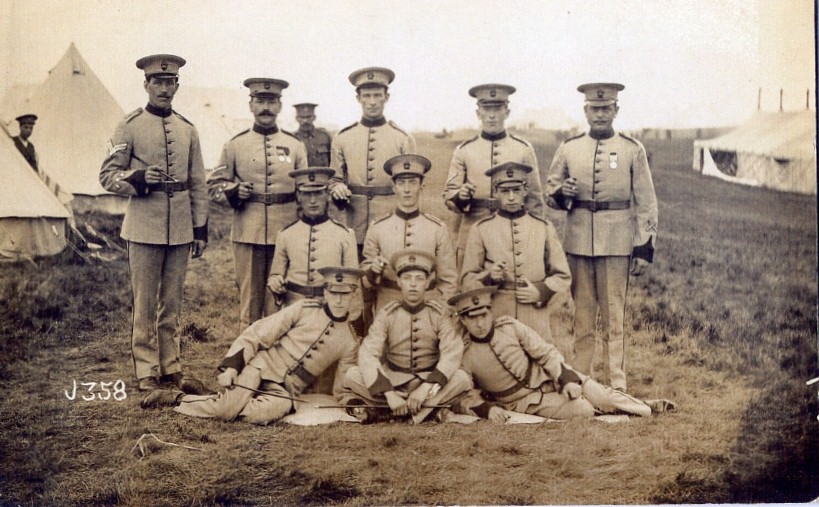
The Tynedale district today (www.tynedale.gov.uk) Introduction On the 20th of April 1915, eleven hundred men from the Tynedale district of Northumberland, embarked for the continent with the local volunteer battalion of the Northumberland…
You must be logged in to view the content of this Chapter.

Redeployment to the Aisne Towards the end of April the 50th Divn was busy training and reorganising in the Roquetoire area when, rumours began to circulate of a move to another part of…
You must be logged in to view the content of this Chapter.
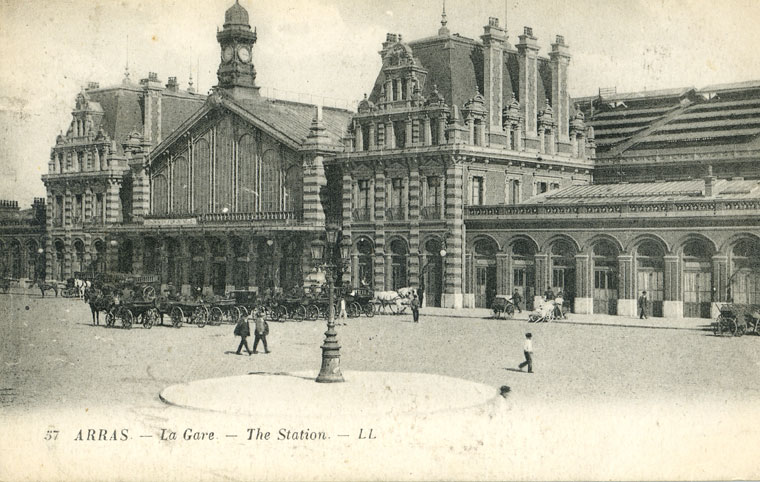
Historical Context The allied plan to launch an offensive on two fronts in the spring of 1917 had started to take shape the year before, but it was put in jeopardy by the…
You must be logged in to view the content of this Chapter.
Summary of events

By the 8th of April the whole of the 50th Divn had move northwards from the Somme to the Merville area and new drafts of men had arrived to replace those lost during March on the Somme. On the 5th Capt Robson had returned with a draft of 250 men for the 4th Bn and on the 6th a further 102 arrived, described in the 4th Bn diary as of poor physique and all under the age of 19.
The 50th Divn were destined to relieve the Portuguese Divn in the front line east of Merville on the night of the 9/10th April. The 151st Bde were to be the first in the front line and in preparation for this had moved into billets in the town of Estaires 1. The 149th Bde were billeted north and west of Merville 2 with the 4th Bn centred on the village of Arrewage 3. During the morning of the 9th events led to the relief plans being rapidly amended.
Tuesday, 9th April 1918
At 4am the Germans opened up with a heavy bombardment of the line between Bethune 4 and Armentieres 5. The towns of Merville, Estaires and La Gorgue 6 were continually hit, reducing houses to rubble and the outbreak of fires was widespread. By 4.30am all communication with the Portuguese Divisional HQ by land line had been cut. The relief orders for the Portuguese were cancelled and the 151st Bde carried out a prearranged move to a series of defence posts south of the River Lys. Between 5 and 5.30am the 149th and 150th Bdes were ‘stood to’ and prepared to move forward at an hours notice. A forward 149th Bde HQ was established at the front, while the rear Bde HQ remained with the Divn (map ref: K29.a).
At 6am orders were issued to the engineers to prepare the River Lys bridges for demolition.

At 7.30am orders were issued for the 149th and 150th Bdes to move to an assembly point at Chapelle Duvelle 7 (map ref: L.26 Central) on the eastern side of Merville. 2nd Lt Kipling went in advance of the Bn to reconnoitre the route and ascertain that it was still possible to get the transport through Merville in view of the heavy shelling it had been subjected to.
The 4th Bn set off at 9.45am and fortunately, only sustained one casualty by the time it reached the outskirts of Merville. The Bn halted here to allow the 5th Bn to pass, then continued through the badly damaged streets of the town, noting that the bridges were still intact.
At 10am, 50th Divn HQ received reports that the Portuguese were under attack and by 11am it was confirmed that the enemy had broken through the lines of the entire Portuguese sector, and had then turned north and south to attack the flanks of the 40th and 55th Divns [zotpressInText item="{4R6FADJ9}"]. The Portuguese retreated through the lines of the 151st Bde, having abandoned all their guns, therefore the position held by the 151st Bde was now the front line.
The 4th Bn reached the assembly point and received orders to take up concealed positions in nearby farms (map ref: L.30.d). The 151st Bde made contact with the enemy around 12 noon and from thereon were involved in fierce fighting during which they were steadily forced back to the Lys and Lawe rivers.
Meanwhile, at 1.15pm, 149th Bde HQ issued orders for the 5th and 6th Bns to move and occupy positions at Trou Bayard 8 (map ref: G.19.G), to the north of Estaires. The 4th Bn stayed where they were, but were placed under the direct orders of 50th Divn HQ. The Bn was not made aware of the dire situation on the front line until after the arrival of the cookers at 2pm and dinner had been served. The Bn was placed at the disposal of the 151st Bde and in accordance with instructions, marched towards the water tank in Estaires. On reaching the outskirts of Estaires, at 3pm Coys moved off the road and deployed in artillery formation, moving forward to take up position in local farms on the northern side of Estaires (map ref: L.23.d) to await battle orders. Under 151st Bde instructions, 'D' Coy were dispatched to guard the railway at Beaupre. Bn HQ was established at a farm (map ref: L.23.d.6.3) and 'A', 'B' and 'C' Coys dug in near strong points, in the vicinity of the water tank. The Bn was in position by 5pm.
Meanwhile 149th Bde HQ was established at 2.30pm alongside 150th Bde HQ at Pont de Poivre 9. During the afternoon the 150th Bde had been taking up defensive positions on the northern bank of the River Lys to the east of Estaires and as far northeast as Sailly. An enemy column, advancing from the south, reached the River Lys near Nouveau Monde 10 around 3pm and was soon firing on the northern bank with machine guns.
At 3.15pm the 5th and 6th Bns NF were in position to provide support for the 150th Bde, with orders to counterattack any part of the front line that may be breached. The line of the rivers Lys and Lawe was to be held at all costs.

At 3.45pm the GOC 150th Bde received a message from Divn HQ stating that the 4th Bde was also moving up to provide support, with orders to counterattack immediately if the enemy should succeed in crossing the river. The Bn arrived and at 5.15pm were immediately placed under the command of Lt Col G.O. Spence (5th DLI (150th Bde)) who coordinating the River Lys defences.
Sgt Thompson with a patrol of fifty men was dispatched to reconnoitre Pont De La Meuse 11 and to establish contact with elements of the 5th DLI who were holding the bridgehead. 2nd Lt Lawson and a patrol of ….. left to reconnoitre Pont Levis 12 and make contact with the 5th DLI at that location. Capt J.V. Gregory (OC 4th Bn) arranged with Lt Col. Spence to send one platoon to map reference L 29a.O.4. The platoon duly moved off and joined Sgt Thompson and his men who were already at that spot.

The remainder of ‘A’ Coy under Lt Nicholson went forward to hold the house on the near side river bank between Pont de la Meuse and Pont Levis.
At 6pm the 6th Bn was ordered to move (map ref: G.15.c) northeast in order to protect the left flank of 150th Bde by patrolling the line of stream running from the north into the Lys (map ref: G.10.b), in case the enemy crossed the river at Bac St Mur 13.
Sgt Wigham led a platoon and two Lewis guns over Pont Levis and reported to the 5th DLI (map ref: G.25.a.8.2).
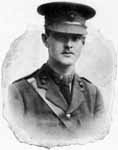
Then, under the command of 2nd Lt Lawson, they set up a defensive position on the far bank covering the bridge approaches.
2nd Lt Lawson, who had just rejoined the Bn after from leave, was wounded near Pont Levis and left behind (he was in fact captured by the enemy and made a good recovery from severe wounds in a German hospital).
Around 7pm, Maj. Gen. Jackson ordered the 151st Bde to withdraw to the northern bank of the Lys and the engineers to destroy the Lys bridges, “because the enemy had brought its field guns forward and was systematically smashing up the bridgehead garrisons at point blank range” ([zotpressInText item="{4R6FADJ9,315}"]). The main bridge at Estaires (Pont de la Meuse?) was successfully blown up, but Pont Levis survived (detonator wires believed to have been cut by shellfire).
At 9.10pm the 5th Bn was ordered to take up a position in strong points near Trou Bayard (map ref: G.19.b) and connect up with the 4th Bn.
At 11.45pm 149th Bde HQ received a message from the 150th Bde stating that the enemy held the Bac St Mur to Croix de Bac road (north and east of Sailly). The enemy was reported to have crossed the canal further north but no definite information was obtained regarding this. The remainder of the night was quite for the Bn and rations were received and distributed to Coys.
For the 50th Divn the first day fighting in the Battle of Estaires was over. The original British line from Givenchy to Bois Grenier had collapsed, and when darkness fell ran roughly Festubert, Le Touret, Le Cason, Vielle Chapelle, Pont Rigneul and round the north of Lestrem. From here the 50th Divn held the northwestern bank of the Lawe and Lys rivers through La Gorgue, passing east of Estaires and on to the west of Sailly aur la Lys. The line then continued to Croix du Bac, north of Fleurbaix and on to just north of Bois Grenier. A big dent on a ten mile front.
Estaires Map

Wednesday, 10th April 1918
At 1.55am, orders were issued for a realignment of the Divn front. These orders, received at 151st Bde HQ at 3.30am, stated that the line was to be realigned before dawn, with the 51st Divn side stepping west and relieving the 8th DLI up to and including Lestrem Bridge 14, the 149th Bde would take over defences currently held by the 5th DLI. This was to be from Pont Levis (incl) to the Lys, opposite Rue de la Lys 15, with one Bn in the front line and two held in reserve. The relief of the 5th DLI was to be carried out by a portion of the 4th Bn, with the remainder of the Bn returning to the command of the 149th Bde. So by dawn the 150th Bde was on the left flank of the Bde front, the 149th in the middle and 151st on the right.

Due to a misunderstanding between the 149th and 150th Bdes, Pont Levis was left unguarded during the night, however, at 5.40am the 4th Bn was ordered to send two platoons to take up a position at the bridge alongside the 5th DLI (may have been 5th Bn NF). Capt Robson set out with two platoons from ‘C’ Coy at 6.30am to try and strengthen the defences at the bridge, but by this time fighting had recommenced. They were immediately held up by heavy machine gun fire on open ground and Capt Robson was wounded. Another attempt at reinforcement was made by a third platoon from 'C' Coy.
Again enemy machine gun fire prevented this and 2nd Lt Davison (accompanying the CO and 2nd Lt Essex) was wounded whilst reconnoitring the position. Despite tough resistance put up by the 5th Bn, elements of the German 35th Divn finally forced their way across Pont Levis around 7.30am.
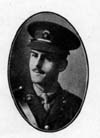
Meanwhile the rest of the Bn had been ordered to redeploy to Ferme Quennelle 16 and returned to the command of the 149th Bde. The move was supposed to have been completed before dawn, but the Bn did not receive the order until it was light. Bn HQ and ‘B’ Coy were held up on the way, so HQ had to be established at map ref L.19.b.3.4, with the revised position notified to Bde HQs.
‘B’ Coy occupied a position at Pont De Poivre (Harlech Strong Point) 17 and made contact with a Coy from the 6th Bn, commanded by Capt Stafford. They were entrenched 100 yards to the rear of Harlech on the opposite side of the Trou Bayard Road. ‘B’ Coy immediately threw out a screen in front that reported the enemy were endeavouring to push machine guns towards them.
Having crossed Pont Levis, Ferme Quennell fell to the enemy as they forced their way into the south eastern part of Estaires and captured some of the houses on the north side of the main street.
Under very difficult circumstances the Bn was reorganised near the Trou Bayard Road, linking up with Bns on either flank.

Bn HQ were informed at 7.30am that the right flank of 'C' Coy was ‘in the air’ and that they were unable to re-establish a link due the number of casualties they had suffered. Sgt Major Osborne took a platoon from ‘B’ Coy to protect the right flank of ‘C’ Coy and eventually succeeded in establishing a line connecting ‘A’ & ‘C’ Coys, taking a few casualties in the process.
At 9.30am the defensive line was reported continuous and the 6th Bn were ordered to counterattack towards Pont Levis to drive the enemy out of Estaires. They passed through the ‘B’ and ‘C’ Coy lines and succeeded in driving the enemy back to the church in Estaires and Pont Levis, but were threatened on the left flank and brought to a standstill.
There were two or three factories near the river which the 6th Bn were able to use to pour machine gun fire on the bridge approaches. Nevertheless, the enemy continued to pour across the bridge and work their way through the houses, gardens and cemetery on the northern side of Estaires, as well head northeast and to the west.
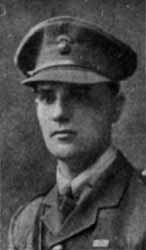
Two platoons from ‘B’ Coy, commanded by 2nd Lt Bull, were ordered to advance in the direction of Pont Levis and report to Major Temperley (OC 6th Bn), but they were subjected to severe machine gun fire on open ground and were held up before reaching their objective, suffering many casualties in the process. Major Temperley informed them that they were no longer required, so those that were left returned to ‘B’ Coy and manned Harlech Strong Point.
By 10.45am Bn HQ had dug in, to the rear of the 5th Bn position. ‘D’ Coy returned from guarding the railway at Beaupre during the morning and was instructed to dig into the rear of the Bn HQ position. For the next few hours it was relatively quiet, although needless to say the Germans continued to strengthen their bridgehead.
A heavy enemy bombardment and attack commenced around 4pm, forcing the 5th Bn to withdraw and leaving the left flank of the 4th Bn exposed. ‘D’ Coy were sent to cover the left flank, reporting themselves ‘well dug in’ between the crossroads at Trou Bayard and Cul De Sac Farm 18, although taking a few casualties in the process.
'A' Coy of the 5th Bn at 'Harlech Strong Point' came under the orders of the OC 4th Bn and two platoons were placed to link up the left Bn and ‘D’ Coy. OC ‘B’ Coy reported that the enemy was moving forward his machine guns slowly and endeavouring to bring enfilade fire on all the strong points at 'Harlech'. The enemy was unable to do this before nightfall and remained in the positions he arrived at. As soon as it was dark ‘A’ Coy of the 5th Bn exchanged places with 'D' Coy thus bringing the Bn together and simplifying the organisation.
Thursday, 11th April 1918
At midnight orders were received stating that 'A' Coy of the 5th NF would be relieved by a Coy from the 4th East Yorks, who would take up a position at map ref: L.23.d.6.3. ''D Coy formed up on their left and the remainder of 'C' Coy withdrew to the rear of Harlech strong point, the position just vacated by 'D' Coy . Bn HQ moved back to a new position which was consolidated before dawn.
By 2am the 149th held a line running from the Estaires - Neuf Berquin road to just west of Trou Bayard. The 5th Bn held the right sector, the 4th the left sector and the 6th were held in reserve. When dawn broke on the 11th, the 151st Bde were on the right flank, the 149th in the centre and 150th on the left. At 7am the enemy was reported to have occupied Trou Bayard.
By 10am 'D' Coy on the left and 'B' Coy were holding their positions against repeated attacks supported by heavy trench mortar and machine gun fire. However, the Bn right flank was now exposed because the 5th DLI (151st Bde) had been forced back, the enemy were heading for Neuf Berquin and the 5th Bn NF had been withdrawn. Harlech Strong Point was very heavily shelled at point blank range from the river at Estaires and was subjected to a considerable amount of gas. The 6th Bn was brought forward to try and re-establish a line, but they were unable to progress very far, so by 2pm the line was gradually being forced back. The Bde maintained contact with the 29th Divn on the left flank, but the right flank was now very exposed.
The Bn war diary indicates that at 2pm "a general withdrawal, necessitated the removal of Battn Hdqrs to a farm at L.10.b.9.6. The afternoon and evening were spent in the collection of stragglers, the reconstruction of the line for defence. The withdrawal was made through the 29th Div who were dug in, in our rear, and & became necessary owing to the withdrawals of the right & left flanks”. Unfortunately, the withdrawal was not communicated to the Coys on the Bn flanks, consequently they only became aware of the situation when they realised the enemy was outflanking them. The Bn was given instructions to dig in alongside the 29th Divn, however, when the 6th NF with two coys moved forward to counterattack the 4th NF moved forward with them. This position appears to have been held for the rest of the day. However, at a conference between Brigadiers that night, a decision was taken to fall back to a new line.
Meanwhile that evening, the enemy on the right flank had entered Merville.
Friday, 12th April 1918
The withdrawal began at 2.30am and by dawn the 149th Bde had vacated its positions at L10b (sheet 36 .. NE) and was on the march to new positions running from the village of Vierhouck (incl) to the crossroads on the Neuf Berquin-Vieux Berquin road (map ref: K.11d.7.8. to L.13.b.16), just south of Pont Rondin. The 4th and 5th Bns under the command of Lt Col Irwin, provided the flank and advanced guards. They were followed by the 6th Bn and a few from the 4th Bn, under the command of Major Temperley, and then the reinforcement Bn under OC Corps Troops.
Information was received that the enemy had machine guns in Neuf Berquin and was firing down the road towards La Couronne. A party from the 4th Bn was sent out before dawn to engage these machine guns, but they were unable to acquire a position of vantage until nearly daylight and were then unable to move forward.
By 6.30am the 149th Bde was reported to have crossed the Neuf Berquin-Vieux Berquin road, encountering light opposition and a half hour later, the 6th Bn had occupied Vierhouck 19, and were forming a defensive flank along the road leading to Pont Rondin 20, their new line running from south of the village round the western edge (map ref; K.12c). The reinforcement and 5th Bn stretching to the Neuf Berquin-Vieux Berquin road. The 4th Bn dug in behind to provide support, at map ref K.12.d.
“The official despatches record that: "At about 8am the enemy attacked in great strength on a front extending from south of the Estaires - Neuf Berquin neighbourhood. After very heavy fighting ... he succeeded in the afternoon in overcoming the resistance of our troops about Doulieu and La Becque, forcing them back in a north-westerly direction.” [zotpressInText item="{4R6FADJ9,333}"]
Due to the failure of the 1st Bn KOSB to link up on the left flank, the 149th Bde was forced to withdraw at 9.30am and take up a position in conjunction with the Guards Bde, who during the night had dug in behind them (map ref: K.12.b and L.7a). At 10.30am, the Guards on the right flank counterattacked the enemy in Neuf Berquin, but were forced to withdraw to their original line. Heavy fighting continued all day and at nightfall (6pm) the relief of the 149th Bde began. The 4th Bn were relieved by the Guards Bde and withdrew to Vieux Berquin where orders were received to march to the transport lines at La Tir Anglais 21 and rest for the night. By this time the 1st Australian Divn were beginning to arrive and were taking up positions in front of the Bois Deval 22 between K 7 b (map ref: 36a N E) and La Couronne.
13th - 16th April 1918
After this much needed respite, the Bn marched to billets in abandoned farms just behind the line and allowed as much sleep as they could get. They had been relieved from actual front line fighting, but along with the rest of Bde were lent to the 5th Divn and set to work digging a defence line through the Bois de Vaches 23. Although returning to billets on the conclusion of work every day, they were under orders to move at ten minutes notice and occupy the defence line if the enemy launched an attack on the Bois de Nieppe 24. These were comparatively quiet days and casualties were few, although there was a certain amount of shelling, particularly from one gun, nicknamed the ‘Silent One’. Its heavy calibre shells arrived before any warning screech was heard, probably due to high velocity.
Bibliography
149th Bde War Diary
4th Bn War Diary
[zotpress items="4R6FADJ9" style="harvard1"]
[zotpress items="NH3TRT6B" style="harvard1"]
[zotpress items="5MC7CZF6" style="harvard1"]
More than 70 fusiliers from the 4th Bn were killed in action or died of wounds during the Battle of the Lys. For information on 4th Bn burial and memorial sites for casualties sustained in the Lys Offensive, select the link.
Extract from:
When the Lantern of Hope Burned Low
“Let me here pay my personal tribute to the Ambulance personnel of the Battalion. The conduct of the stretcher bearers was superb. Roads were shelled and swept by machine gun fire alternately. Two or three squads were knocked out – one whilst carrying Lieut Stiles of the Trench Mortar Battery – but, driven off the roads, the indomitable SB’s carried their wounded comrades across the fields, over ditches, sometimes more than two miles. The Regimental Aid Post was hit by a shell when crowded to the doors with stretcher cases from our own and a neighbouring Division. Yet Capt Grierson went about his work of mercy unresting, unhasting, a fine example to all”. [zotpressInText item="{NH3TRT6B,43}"]
The Lys - Military Units
1st (Australian) Division - Consisted of the 1st, 2nd and 3rd Infantry Bdes
The 1st (Australian) Bde - Comprised of the 1st, 2nd, 3rd and 4th Bns.
The 2nd (Australian) Bde - Comprised of the 5th, 6th, 7th and 8th Bns.
The 3rd (Australian) Bde - Comprised of the 9th, 10th, 11th and 12th Bns.
29th Division - Consisted of the 86th, 87th & 88th Bdes
The 86th Bde - Comprised of the 2nd Bn - Royal Fusiliers, 1st Bn - Lancashire Fusiliers and 1st Bn - Royal Guernsey Light Infantry.
The 87th Bde - Comprised of the 2nd Bn - South Wales Borderers, 1st Bn - King’s Own Scottish Borderers and 1st Bn - Border Regt.
The 88th Bde - Comprised of the 4th Bn - Worcestershire Regt, 2nd Bn - Hampshire Regt and 1st Bn - Newfoundland Regt.
31st Division - Consisted of the 4th Guards Bde, 92nd and 93rd Bdes.
The 4th (Guards) Bde - Comprised of the 4th Bn - Grenadier Guards, 3rd Bn - Coldstream Guards and 2nd Bn - Irish Guards.
The 92nd Bde - 10th & 11th Bn - East Yorkshire Regt, 11th Bn - East Lancashire Regt.
The 93rd Bde - 15/17th & 18th Bn West Yorkshire Regt, 13th Bn - York and Lancaster Regt.
40th Division - Consisted of the 119th, 120th & 121st Bdes.
The 119th Bde - Comprised of the 13th Bn - East Surrey Regt, 18th Bn - Welsh Regt. 21st Bn - Middlesex Regt.
The 120th Bde - Comprised of the 2nd Bn - Royal Scots Fusiliers, 10/11th Bn & 14th Bn - Highland Light Infantry.
The 121st Bde - Comprised of the 12th Bn - Suffolk Regt, 13th Bn - Yorkshire Regt. 20th Bn - Middlesex Regt.
50th (Northumbrian) Division Consisted of the 149th, 150th & 151st Bdes.
The 149th (Northumberland) Bde comprised of the 1/4th, 1/5th & 1/6th Bn - Northumberland Fusiliers.
The 150th (York & Durham) Bde - Comprised of 1/4th Bn - East Yorkshire Regt, 1/4th and 1/5th Bn - Green Howards.
The 151st (Durham Light Infantry) Bde - 1/5th, 1/6th and 8th Bn - DLI.
51st Division - Comprised of the 152nd, 153rd and 154th Infantry Brigades.
The 152nd Bde 1/5th and 1/6th Bn - Seaforth Highlanders, 1/6th Bn - Gordon Highlanders.
The 153rd Bde 1/6th and 1/7th Bn - Black Watch, 1/7th Bn - Gordon Highlanders.
The 154th Bde 1/4th Bn - Seaforth Highlanders, 1/4th Bn - Gordon Highlanders, and 1/7th Bn - Argyll and Sutherland Highlanders.
55th Division - Consisted of the 164th, 165th and 166th Bdes.
The 164th Bde - Comprised of the 1/4th Bn - King’s Own (Royal Lancaster Regt), 2/5th Bn - Lancashire Fusiliers and 1/4th - Bn Loyal North Lancashire Regt.
The 165th Bde - 1/5th, 1/6th & 1/7th Bn - King’s (Liverpool) Regt.
The 166th Bde - 1/5th Bn King’s Own (Royal Lancaster Regt), 1/10th Bn - King’s (Liverpool) Regt and 1/5th Bn - South Lancashire Regt.
Related websites
Cecil Slack & the Great War - www.greatwar.eril.net/diary.htm - Diaries of an officer in the 4th Bn East Yorkshire Regt (150th Bde) during the Battle of the Lys.
http://www.estaires.com This a website devoted to the modern day city of Estaires and includes many aerial photographs of the locations described in the text above.
Bibliography
[zotpress items="HUXKQ9EA" style="harvard1"]
If would like to read the full story of the 4th NF in World War 1, then please select here
.
.
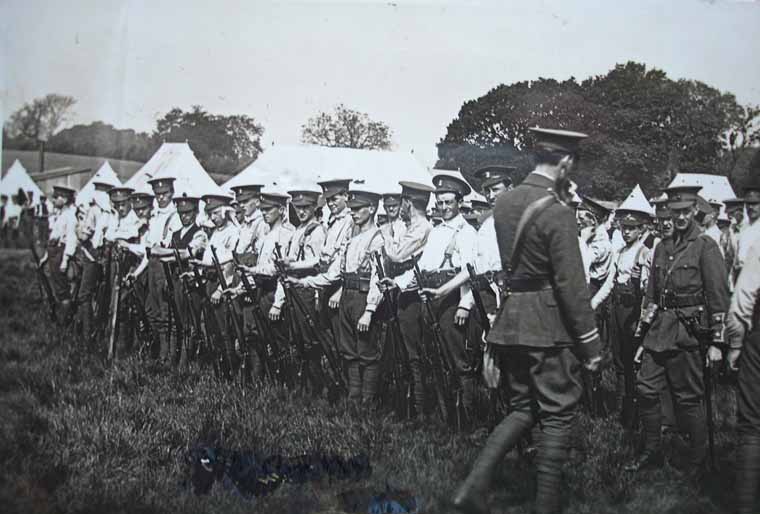
By November 1914 the Bns had been divided to form 'Service' and 'Reserve' battalions. The main function of the 'Reserve' battalion was to train new recruits for the 'Service' battalion (for when it was finally deployed overseas) and to continue with home defence. Both battalions were billeted in Blyth, Northumberland, however, staff of the reserve battalion based at the Hexham depot continued to recruit and train new personnel. Early in 1915, after an Army reorganisation, the Service battalion became known as the 1/4th (1st line battalion) and the Reserve battalion as the 2/4th (2nd line battalion). For a few months the 2/4th battalion continued to recruit and train men for the 1/4th, but after a further reorganisation it became part of the 188th Bde, 63rd (Home Service) Division. During Nov 1916, the 2/4th was transferred to the 72nd Division, but continued with home defence duties.
The 3/4th battalion was formed at Hexham during Jan 1915 to continue with the recruiting and training role, however, after another reorganisation in April 1916 the 3/4th became the 4th (Reserve) Battalion and in September 1916 the 5th, 6th and 7th (Reserve) Bns were absorbed by the 4th Reserve Battalion.
An infantry Bn in 1914 was usually comprised of a HQ and eight companies (coys). A full strength coy was as follows:
1 x Captain (Capt)
2 x Lieutenant (Lt) or 2nd Lt
1 x Colour Sergeant (Col Sgt)
2 x Sergeant (Sgt)
2 x Drummer/Bugler
5 x Corporal (Cpl)
100 x Private (Pte)
2 x Driver (Pte)
3 x Batman
(Numbered 149th Inf Bde on 12 May 1915)
HQ - Newcastle-on-Tyne
OC - Brigadier General James Foster Riddell
was comprised of the:
4th Battalion - Northumberland Fusiliers
5th Battalion - Northumberland Fusiliers
6th Battalion - Northumberland Fusiliers
7th Battalion - Northumberland Fusiliers
Select links to learn more about these Battalions
Return to Divisional organisation
HQ - Hexham
CO - Lt Col A.J. Foster
November 1914
The Companies (Coys) of the 4th Bn were:
'A' Coy - Hexham
'B' Coy - Bellingham
'C' Coy - Haydon Bridge
'D' Coy - Prudhoe
'E' Coy - Corbridge
'F' Coy - Haltwhistle
'G' Coy - Newburn
'H' Coy - Prudhoe
Note: During Jan 1915, the battalion was reorganised to form four companies. 'E' Company amalgamated with 'A', 'G' with 'B', 'F' with 'C' and 'H' with 'D'.
Select links to learn more about these Companies
HQ - Newcastle-on-Tyne
CO - Lt Col A.H. Coles
November 1914
'A' Company (Coy) - Walker
'B' Coy - Walker
'C' Coy - Walker
'D' Coy - Wallsend
'E' Coy - Wallsend
'F' Coy - Wallsend
'G' Coy - Gosforth
'H' Coy - Gosforth
HQ - Newcastle-on-Tyne
CO - Lt Col G.R.B Spain
November 1914
'A' Company (Coy) - St Georges Drill Hall, Northumberland Road, Newcastle?
'B' Coy -
'C' Coy -
'D' Coy -
'E' Coy -
'F' Coy -
'G' Coy -
'H' Coy -
HQ - Alnwick
CO - Lt Col R Scott
November 1914
'A' Company (Coy) - Morpeth
'B' Coy - Ashington
'C' Coy - Belford
'D' Coy - Alnwick
'E' Coy - Amble
'F' Coy - Alnwick
'G' Coy - Berwick on Tweed
'H' Coy - Berwick on Tweed
63rd (2nd Northumbrian) Division comprised the 188th, 189th and 190th Bdes.
The 188th (2nd Northumberland) Brigade - Comprised of the 2/4th, 2/5th, 2/6th and 2/7th Bn - Northumberland Fusiliers.
The 189th (2nd York and Durham) Brigade - Comprised of the 2/4th Bn - East Yorkshire Regt, 2/4th and 2/5th Bn - Yorkshire Regt. 2/5th Bn - Durham Light Infantry.
The 190th (2nd Durham Light Infantry) Brigade - Comprised of the 2/6th, 2/7th, 2/8th and 2/9th Bn - Durham Light Infantry.
72nd Division comprised the 215th, 216th and 217th Bdes.
The 215th Brigade - Comprised of the 28th, 70th and 81st Provisional Bn.
The 216th Brigade - Comprised of the 83rd Provisional Bn, 14th Bn - King’s Own Yorkshire Light Infantry and 10th Bn - Somerset Light Infantry.
The 217th Brigade - Comprised of the 2/4th, 2/5th and 2/6th Bn - Northumberland Fusiliers.


